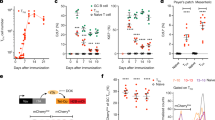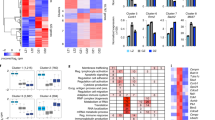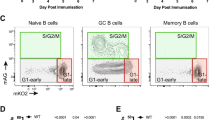Abstract
THE high affinity of antibodies produced during responses to T-cell-dependent antigens is associated with somatic mutation in the variable region of the immunoglobulin1–4. Indirect evidence indicates that: (1) this arises by a process of hypermutation, acting selectively on rearranged immunoglobulin variable-region genes, which is activated in centroblasts within germinal centres; and (2) centrocytes, the progeny of centroblasts, undergo selection on the basis of their ability to receive a positive signal from antigen5. We have now performed experiments analysing this selection process, and found that, on culture, centrocytes isolated from human tonsil kill themselves within a few hours by apoptosis6. This is not a feature of other tonsillar B cells. Centrocytes can be prevented from entering apoptosis if they are activated both through their receptors for antigen and a surface glycoprotein recognized by CD40 antibodies7,8.
This is a preview of subscription content, access via your institution
Access options
Subscribe to this journal
Receive 51 print issues and online access
$199.00 per year
only $3.90 per issue
Buy this article
- Purchase on Springer Link
- Instant access to full article PDF
Prices may be subject to local taxes which are calculated during checkout
Similar content being viewed by others
References
Gearhart, P. J., Johnson, N. D., Douglas, R. & Hood, L. Nature 291, 29–34 (1981).
Bothwell, A. M. et al. Cell 24, 625–637 (1981).
Tonegawa, S. Nature 302, 575–581 (1983).
Griffiths, G. M., Berek, C., Kaartinen, M. & Milstein, C. Nature 312, 271–275 (1984).
MacLennan, I. C. M. & Gray, D. Immunol. Rev. 91, 61–85 (1986).
Wyllie, A. H., Morris, R. G., Smith, A. L. & Dunlop, D. J. Path. 142, 67–77 (1982).
Clark, E. A. & Ledbetter, J. A. Proc. natn. Acad. Sci. U.S.A. 83, 4494–4498 (1986).
Ling, N. R., MacLennan, I. C. M. & Mason, D. Y. in Leucocyte Typing III (eds A. J. McMichael et al.) 302–335 (Oxford University Press, 1987).
Smith, C. A., Williams, G. T., Kingston, R., Jenkinson, E. J. & Owen, J. J. T. Nature 337, 181–184 (1989).
Tew, J. G. & Mandel, T. E. Immunology 37, 69–76 (1979).
Szakal, A. K., Kosco, M. H. & Tew, J. G. J. Immun. 140, 341–353 (1988).
MacLennan, I. C. M., Gotch, F. M. & Golstein, P. Immunology 39, 109–117 (1980).
MacLennan, I. C. M. & Golstein, P. J. Immun. 121, 2542–2546 (1978).
Fliedner, T. M., Kesse, M., Cronkite, E. P. & Robertson, J. S. Ann. N.Y. Acad. Sci. 11, 578–594 (1964).
MacLennan, I. C. M., Liu, Y-J. & Ling, N. R. Curr. Topics Microbiol. Immunol. 141, 138–148 (1988).
Berek, C. & Milstein, S. Immunol. Rev. 96, 23–41 (1987).
Kraal, G., Hardy, R. R., Gallatin, W. M., Weissman, I. R. & Butcher, E. C. Eur. J. Immun. 16, 829–834 (1986).
Klaus, G. G. B., Humphrey, J. H., Kunkle, A. & Dongworth, D. W. Immunol. Rev. 53, 3–28 (1980).
Coico, R. F., Bhogal, B. S. & Thorbecke, G. J. J. Immun. 131, 2254–2257 (1983).
Tsujimoto, Y., Cossman, J., Jaffe, E. & Croce, C. M. Science 228, 1440–1443 (1985).
Graninger, W. B., Seto, M., Boutain, B., Goldman, P. & Korsemyre, S. J. J. clin. Invest. 80, 1512–1515 (1987).
Vaux, D. L., Cory, S. & Adams, J. M. Nature 335, 440–442 (1988).
McDonnell, T. J. et al. Cell 57, 79–88 (1989).
Walker, L. et al. Immunology 58, 533–589 (1986).
Ling, N. R., Bishop, S. & Jefferis, R. J. Immunol. Meth. 15, 279–289 (1979).
Gill, P. G., Waller, X. A. & MacLennan, I. C. M. Immunology 33, 873–880 (1977).
Lebacq-Verheyden, A. M. et al. Int. J. Cancer 32, 237–279 (1983).
Van Camp, B., Thielmans, C. & Dehou, M. F. J. clin. Immun. 2, 67–74 (1982).
Kung, P. C., Goldstein, G., Reinhertz, E. L. & Schlossman, S. F. Science 206, 347–349 (1979).
Partridge, L. J., Lowe, J., Hardie, D. L., Ling, N. R. & Jefferis, R. J. Immun. 128, 1–6 (1982).
Author information
Authors and Affiliations
Rights and permissions
About this article
Cite this article
Liu, YJ., Joshua, D., Williams, G. et al. Mechanism of antigen-driven selection in germinal centres. Nature 342, 929–931 (1989). https://doi.org/10.1038/342929a0
Received:
Accepted:
Issue Date:
DOI: https://doi.org/10.1038/342929a0
This article is cited by
-
Follicular helper T cells: potential therapeutic targets in rheumatoid arthritis
Cellular and Molecular Life Sciences (2021)
-
B is for ‘Big Mac’: GCs crave a high-fat diet
Nature Immunology (2020)
-
Biomedical Applications of Biogenic Zinc Oxide Nanoparticles Manufactured from Leaf Extracts of Calotropis gigantea (L.) Dryand.
BioNanoScience (2020)
-
CD40 polymorphisms were associated with HCV infection susceptibility among Chinese population
BMC Infectious Diseases (2019)
-
Avidity of anti-malarial antibodies inversely related to transmission intensity at three sites in Uganda
Malaria Journal (2017)
Comments
By submitting a comment you agree to abide by our Terms and Community Guidelines. If you find something abusive or that does not comply with our terms or guidelines please flag it as inappropriate.



